Sum of the Magnitude for Hard Decision Decoding Algorithm Based on Loop Update Detection
Abstract
:1. Introduction
2. Basic Definitions
3. Algorithm Description
3.1. Sum of the Magnitude of Weighted Symbol Flipping Decoding Algorithm
- Step 1: Initialization parameters
- Set initial iterations
- Calculate the initial hard decision output sequence, before using this sequence as the output of the decoding iteration in , which is denoted as
- 3.
- Calculate the probability vector
- 4.
- Compute the reliability of the external information of the received symbol
- Step 2: Calculating check equation
- Step 3: , if the ( is the maximum number of iterations set for the user), the decoding is declared to fail and stop.
- Step 4: Determining the position of the flip symbol
- Step 5: Determining the value or magnitude of the flip
- Step 6: Decoding, according to the results of the flip to get a new hard decision decoding sequence.
3.2. Loop Update Detection Algorithm
- (1)
- If an infinite loop is detected and F does not reach the maximum b, we increase the value of F by 1. After this, we return to step 2 to re-determine the position of the specific bit to be flipped by the symbol, before flipping the F bits of the corresponding position.
- (2)
- If an infinite loop is detected but F has reached the maximum b, the currently selected flip symbol position is stored in the exclusion symbol sequence A. F is set to 1 and the flip symbol position is rediscovered.
- (3)
- If no infinite loop is detected, the exclusion symbol sequence A is set as an empty set, the bit flipping identifier F is 1 and the calibration equation is recalculated.
4. Complexity Analysis
5. Simulation Results and Statistical Analysis
5.1. Weighted Factor Test
5.2. Comparison of Algorithm Performance and Average Iteration Numbers
6. Conclusions
Acknowledgments
Author Contributions
Conflicts of Interest
References
- Naga, B.; Li, J.Y.; Durga, P.M. Network densification: The dominant theme for wireless evolution into 5G. IEEE Commun. Mag. 2014, 52, 82–89. [Google Scholar]
- Guo, L.; Ning, Z.L.; Song, Q.Y. Joint encoding and grouping multiple node pairs for physical-layer network coding with low-complexity algorithm. IEEE Trans. Veh. Technol. 2017, 66, 9275–9286. [Google Scholar] [CrossRef]
- Wang, L.S.; Wang, Y.M.; Ding, Z.Z. Cell selection game for densely-deployed sensors and mobile devices in 5G networks integrating heterogeneous cells and internet of things. Sensors 2015, 15, 24230–24256. [Google Scholar] [CrossRef] [PubMed]
- Fortuna, C.; Bekan, A.; Javornik, T. Software interfaces for control, optimization and update of 5G type communication networks. Comput. Netw. 2017, 129, 373–383. [Google Scholar] [CrossRef]
- Gao, X.; Ove, E.; Fredrik, R. Massive MIMO performance evaluation based on measured propagation data. IEEE Trans. Wirel. Commun. 2015, 14, 3899–3911. [Google Scholar] [CrossRef]
- Cheng, L.; Zhu, H.; Li, G. LDPC encoder design and FPGA implementation in deep space communication. In Proceedings of the International Conference on Logistics, Engineering, Management and Computer Science, Shenyang, China, 24–26 May 2014; pp. 343–346. [Google Scholar]
- Wang, C.L.; Chen, X.H.; Li, Z.W. A simplified Min-Sum decoding algorithm for non-binary LDPC codes. IEEE Trans. Commun. 2015, 61, 24–32. [Google Scholar] [CrossRef]
- Marc, P.C.F.; Miodrag, J.M.; Hideki, I. Reduced complexity iterative decoding of low-density parity check node based on belief propagation. IEEE Trans. Commun. 1999, 47, 673–680. [Google Scholar]
- Aslam, C.A.; Guan, Y.L.; Cai, K. Edge-based dynamic scheduling for belief-propagation decoding of LDPC and R S codes. IEEE Trans. Commun. 2017, 65, 525–535. [Google Scholar] [CrossRef]
- Namrata, P.B.; Brijesh, V. Design of hard and soft decision decoding algorithms of LDPC. Int. J. Comput. Appl. 2014, 90, 10–15. [Google Scholar]
- Evdal, A.; Najeeb, U.H.; Michael, L. Challenges and some new directions in channel coding. J. Commun. Netw. 2015, 17, 328–338. [Google Scholar] [Green Version]
- Balasuriya, N.; Wavegedara, C.B. Improved symbol value selection for symbol flipping-based non-binary LDPC decoding. EURASIP J. Wirel. Commun. Netw. 2017, 2017, 105. [Google Scholar] [CrossRef]
- Chen, M.; Hao, Y.X.; Qiu, M.K. Mobility-Aware caching and computation off loading in 5G ultra-dense cellular network. Sensors 2016, 16, 974. [Google Scholar] [CrossRef] [PubMed]
- Swapnil, M. High-Throughput FPGA QC-LDPC Decoder Architecture for 5G Wireless; The State University of New Jersey: Rutgers, NJ, USA, 2015. [Google Scholar]
- Kou, Y.; Lin, S.; Fossorier, M. Low-density parity-check codes based on finite geometries: A rediscovery and new results. IEEE Trans. Inf. Theory 2001, 47, 2711–2736. [Google Scholar] [CrossRef]
- Zhang, J.; Fossorier, M. A modified weighted bit-flipping decoding of low-density parity-check codes. IEEE Commun. Lett. 2004, 8, 165–167. [Google Scholar] [CrossRef]
- Jiang, M.; Zhao, C.M.; Shi, Z. An improvement on the modified weighted bit flipping decoding algorithm for LDPC codes. IEEE Commun. Lett. 2005, 9, 814–816. [Google Scholar] [CrossRef]
- Guo, R.; Liu, C.; Wang, M. Weighted symbol-flipping decoding for non-binary LDPC codes based on average probability and stopping criterion. J. Commun. 2016, 37, 43–52. [Google Scholar]
- Zhang, G.Y.; Zhou, L.; Su, W.W. Average magnitude based weighted bit-flipping decoding algorithm for LDPC codes: Average magnitude based weighted bit-flipping decoding algorithm for LDPC codes. J. Electron. Inf. Technol. 2014, 35, 2572–2578. [Google Scholar] [CrossRef]
- Garcia-Herrero, F.; Li, E.B.; Declercq, D. Multiple-Vote Symbol-Flipping Decoder for Nonbinary LDPC Codes. IEEE Trans. Very Large Scale Integr. Syst. 2014, 11, 2256–2267. [Google Scholar] [CrossRef]
- Garcia-Herrero, F.; Declercq, D.; Valls, J. Non-binary LDPC decoder based on symbol flipping with multiple votes. IEEE Commun. Lett. 2014, 18, 749–752. [Google Scholar] [CrossRef]
- Nhan, N.Q.; Ngatched, T.M.N.; Dobre, O.A. Multiple-votes parallel symbol-flipping decoding algorithm for non-binary LDPC codes. IEEE Commun. Lett. 2015, 19, 905–908. [Google Scholar] [CrossRef]
- Ueng, Y.L.; Wang, C.Y.; Li, M.R. An efficient combined bit-flipping and stochastic LDPC decoder using improved probability traces. IEEE Trans. Signal Process. 2017, 65, 5368–5380. [Google Scholar] [CrossRef]
- Le, K.; Ghaffari, F.; Declercq, D. Efficient hardware implementation of probabilistic gradient descent bit-flipping. IEEE Trans. Circuits Syst. I Regul. Pap. 2017, 64, 906–917. [Google Scholar] [CrossRef]
- Lu, M. Research on Construction and Decoding Algorithm of Nonbinary LDPC Codes; Beijing Jiaotong University: Beijing, China, 2013. [Google Scholar]
- Mackay, D.J.; Wilson, S.T.; Davey, M.C. Comparison of constructions of irregular Gallager codes. IEEE Trans. Commun. 1999, 47, 1449–1454. [Google Scholar] [CrossRef]
- Garcia-Herrero, F.; Canet, M.J.; Valls, J. Nonbinary LDPC Decoder Based on Simplified Enhanced Generalized Bit-Flipping Algorithm. IEEE Trans. Very Large Scale Integr. Syst. 2014, 22, 1455–1459. [Google Scholar] [CrossRef]
- Thi, H.P. Two-Extra-Column Trellis Min-max Decoder Architecture for Nonbinary LDPC Codes. IEEE Trans. Very Large Scale Integr. Syst. 2017, 25, 1781–1791. [Google Scholar] [CrossRef]
- Guo, F.; Hanzo, L. Reliability ratio based weighted bit-flipping decoding for low-density parity-check codes. Electron. Lett. 2004, 40, 1356–1358. [Google Scholar] [CrossRef]
- Zhang, J.Y. Simplified symbol flipping algorithms for nonbinary low-density parity-check codes. IEEE Trans. Commun. 2017, 65, 4128–4137. [Google Scholar] [CrossRef]
- Liu, B.; Tao, W.; Dou, G.Q. Weighted symbol-flipping decoding for nonbinary LDPC codes based on a new stopping criterion. J. Electron. Inf. Technol. 2011, 33, 309–314. [Google Scholar] [CrossRef]
- Sulek, W. Non-binary LDPC decoders design for maximizing throughput of an FPGA implementation. Circuits Syst. Signal Process. 2016, 35, 4060–4080. [Google Scholar] [CrossRef]
- Kang, J.Y.; Huang, Q.; Zhang, L. Quasi-cyclic LDPC codes: An algebraic construction. IEEE Trans. Commun. 2010, 58, 1383–1396. [Google Scholar] [CrossRef]
- Jiang, X.Q.; Hai, H.; Wang, H.M. Constructing large girth QC protograph LDPC codes based on PSD-PEG algorithm. IEEE Access 2017, 5, 13489–13500. [Google Scholar] [CrossRef]
- Bai, Z.L.; Wang, X.Y.; Yang, S.S. High-efficiency Gaussian key reconciliation in continuous variable quantum key distribution. Sci. China Phys. Mech. Astron. 2016, 59, 614201. [Google Scholar] [CrossRef]
- Chang, T.C.Y.; Su, Y.T. Dynamic weighted bit-flipping decoding algorithm for LDPC codes. IEEE Trans. Commun. 2015, 63, 3950–3963. [Google Scholar] [CrossRef]
- Bazzi, L.; Audah, H. Impact of redundant checks on the LP decoding thresholds of LDPC codes. IEEE Trans. Inf. Theory 2015, 61, 2240–2255. [Google Scholar] [CrossRef]
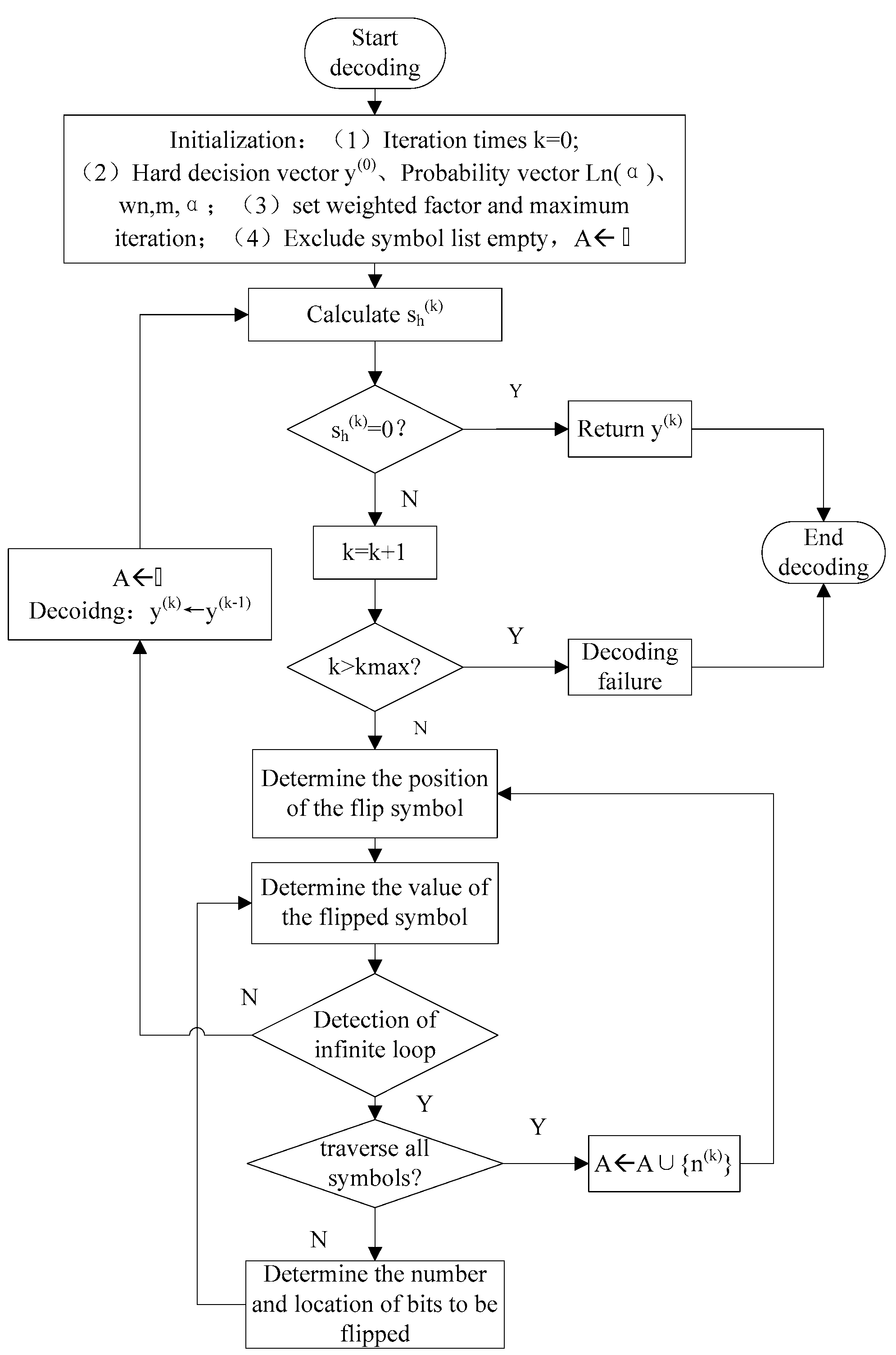
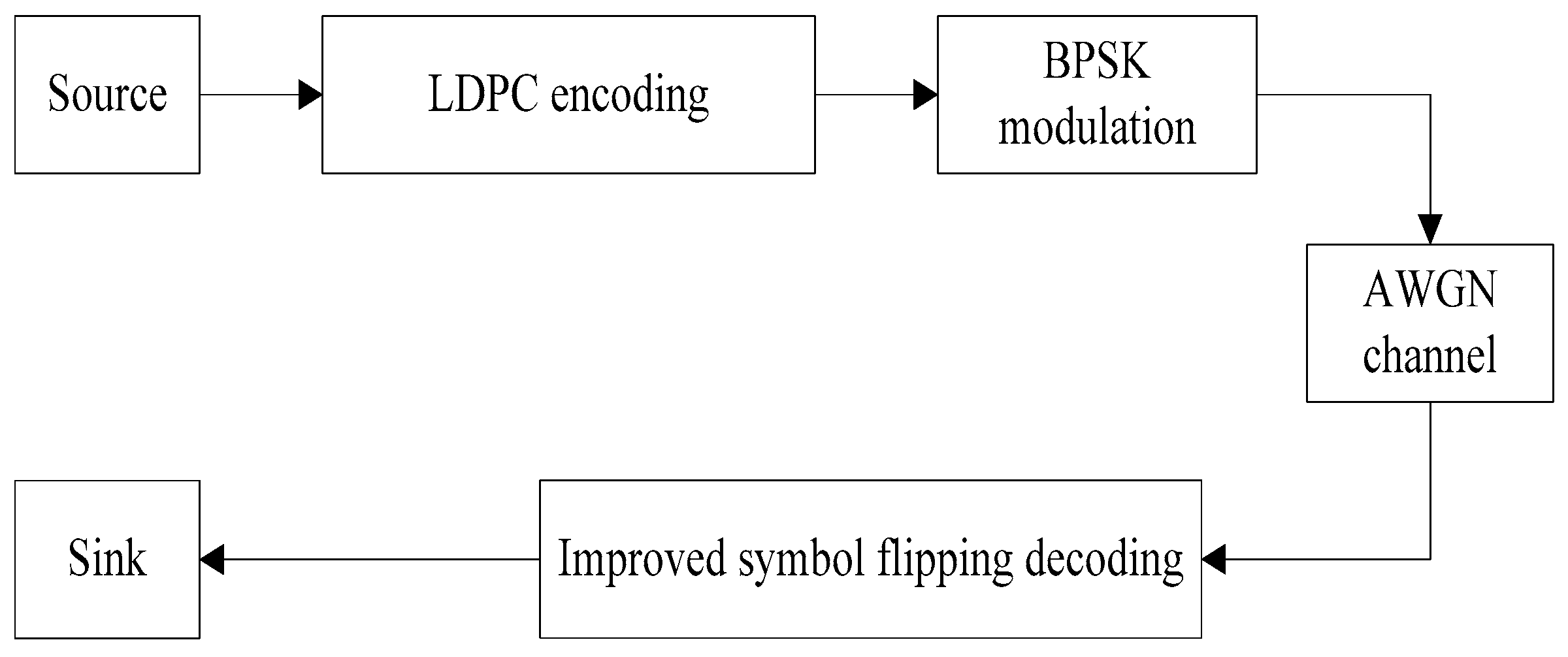
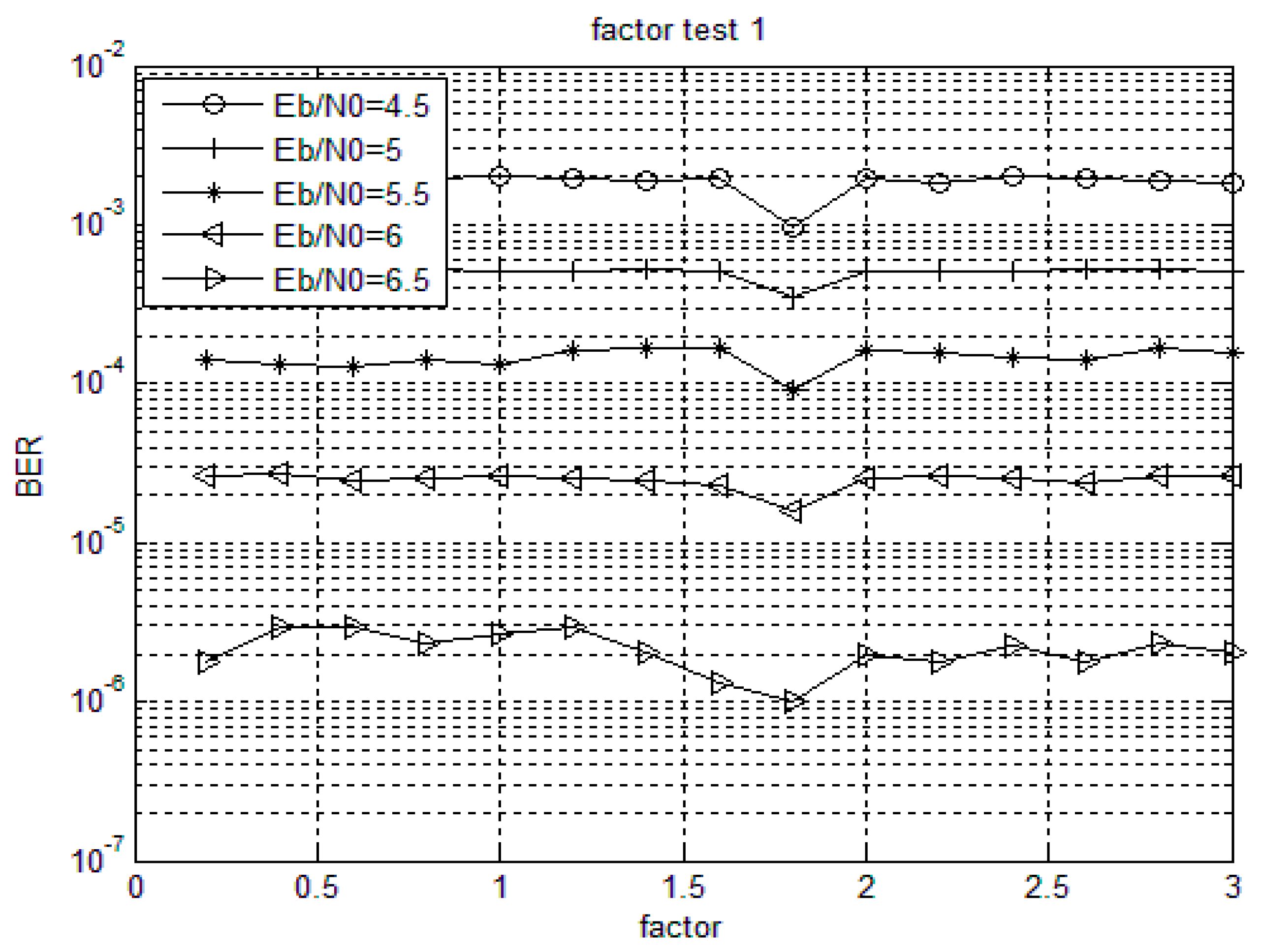
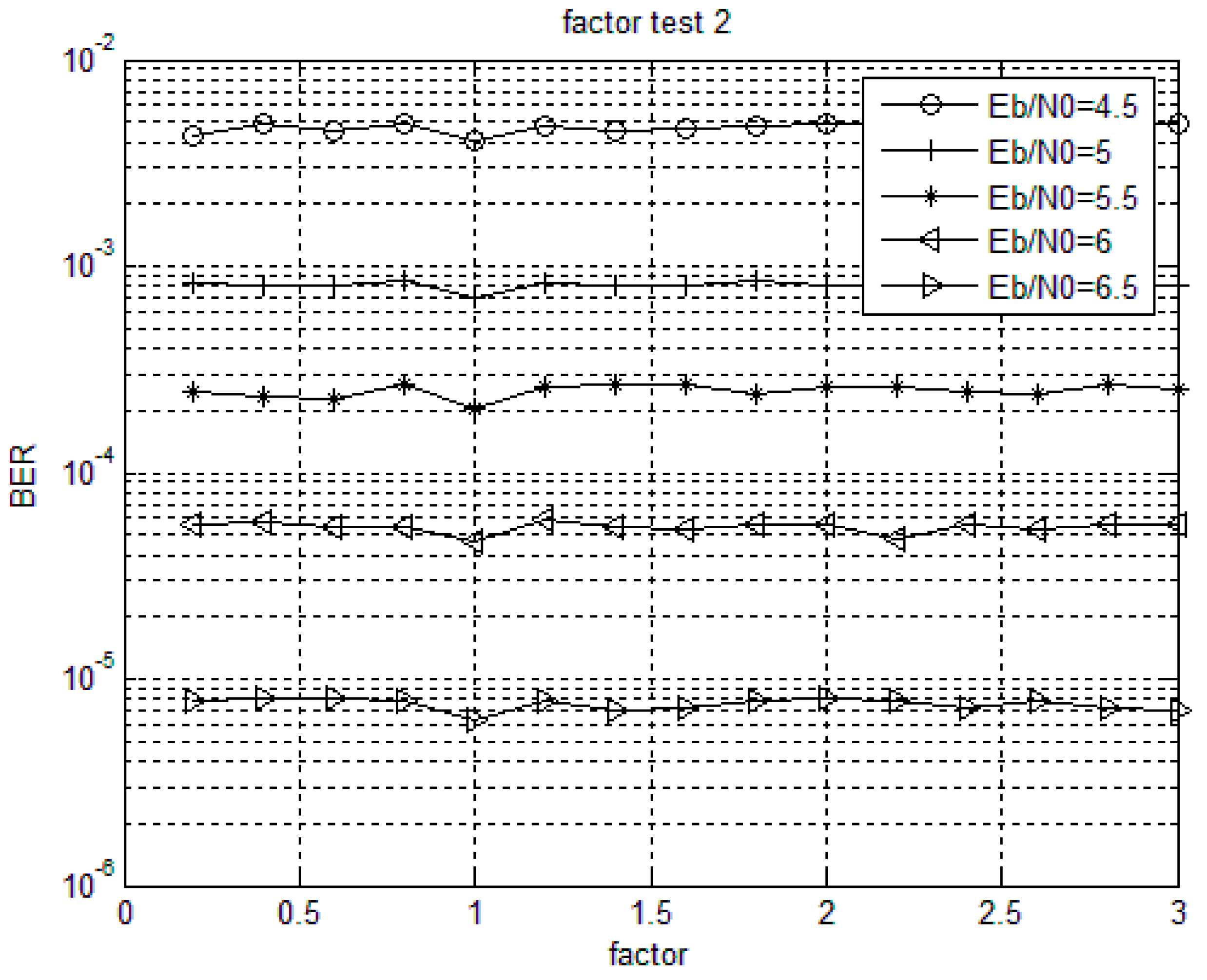

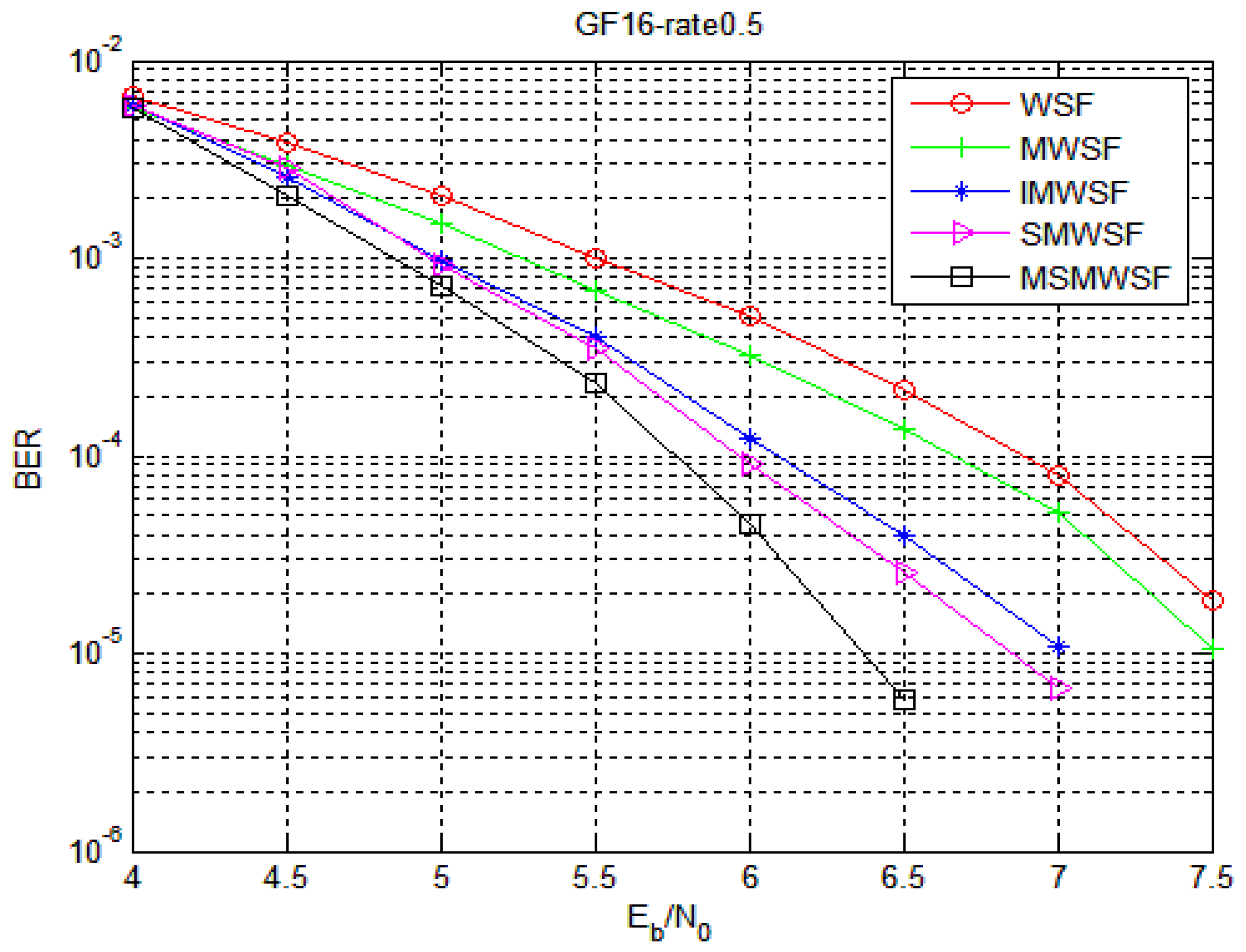
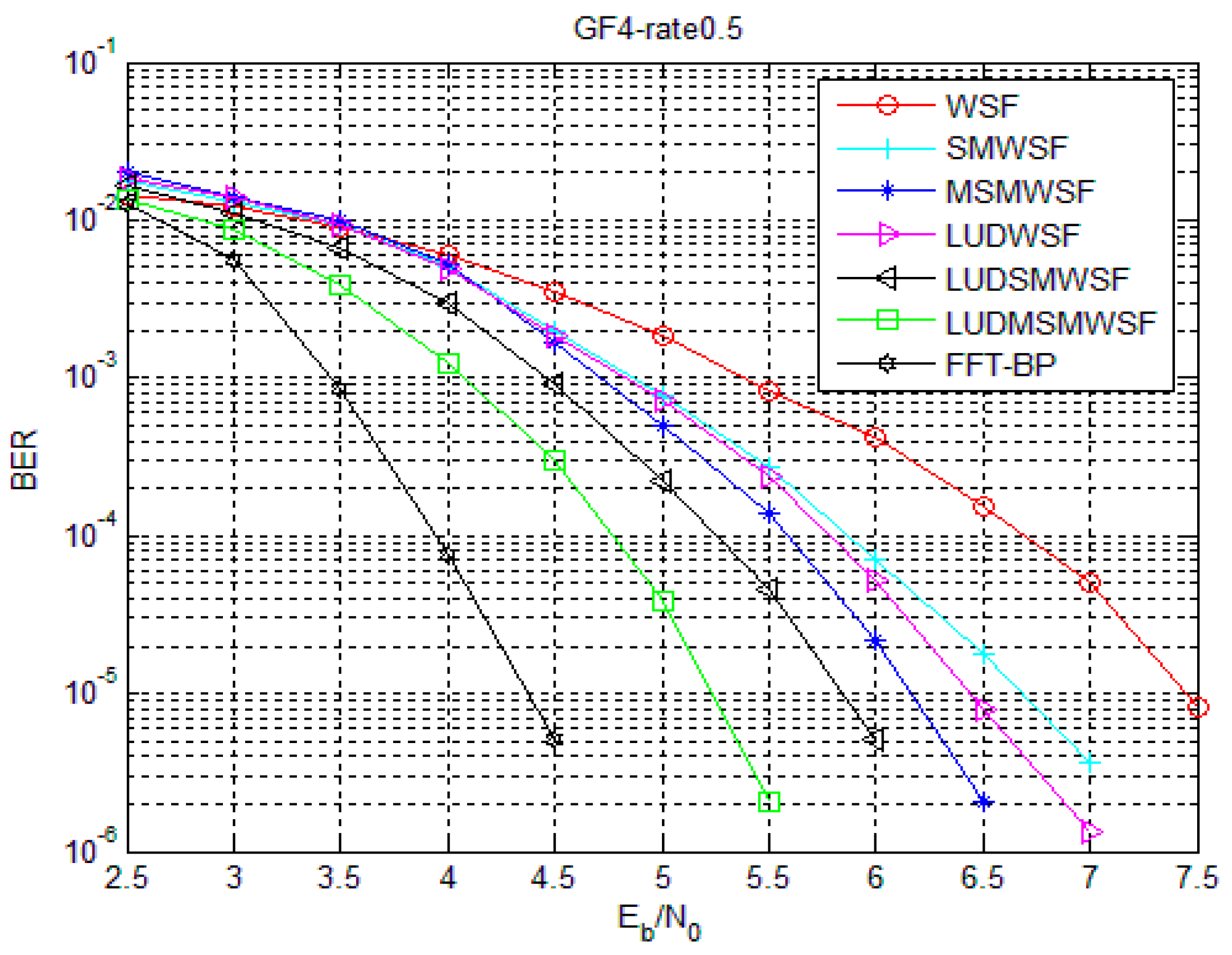
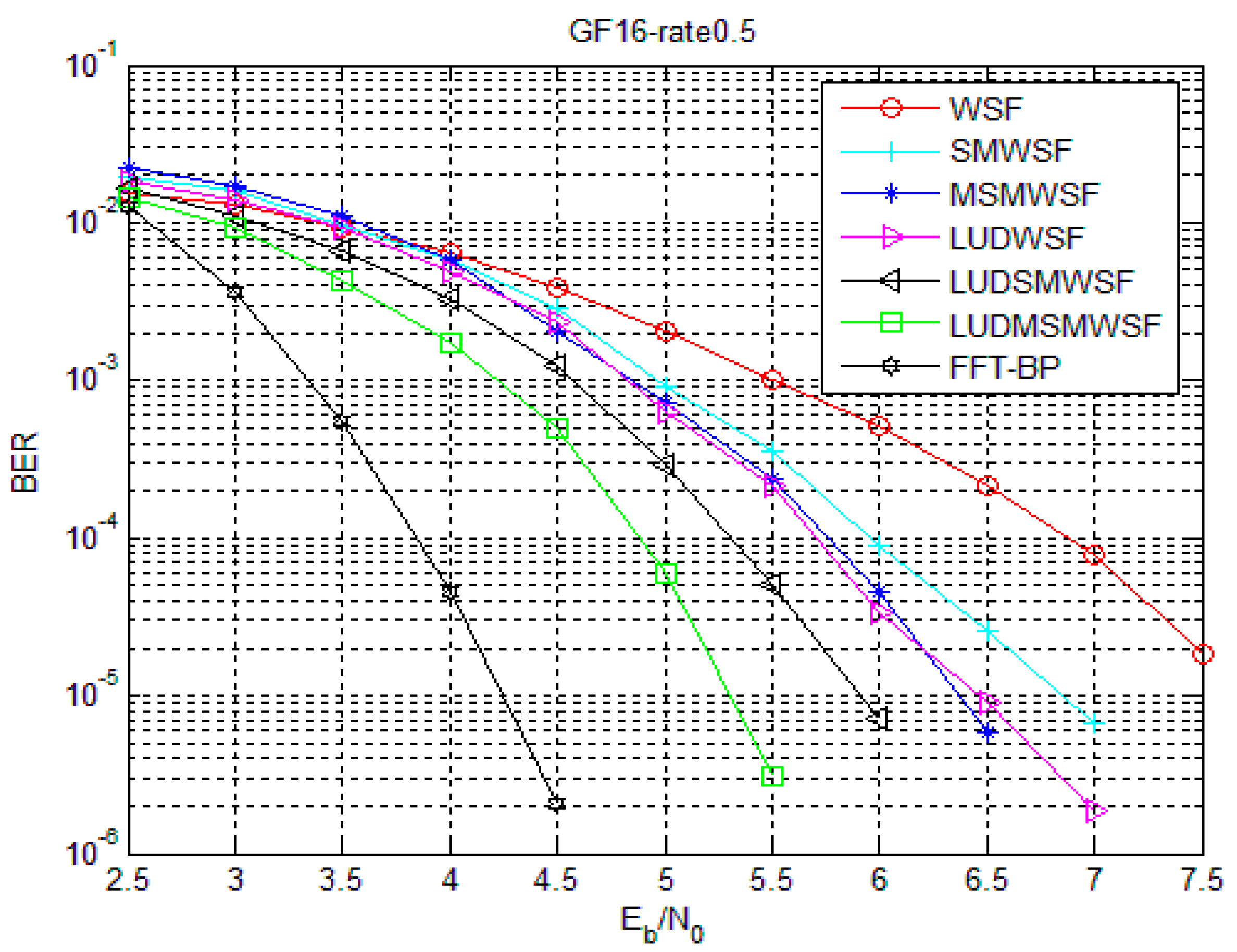

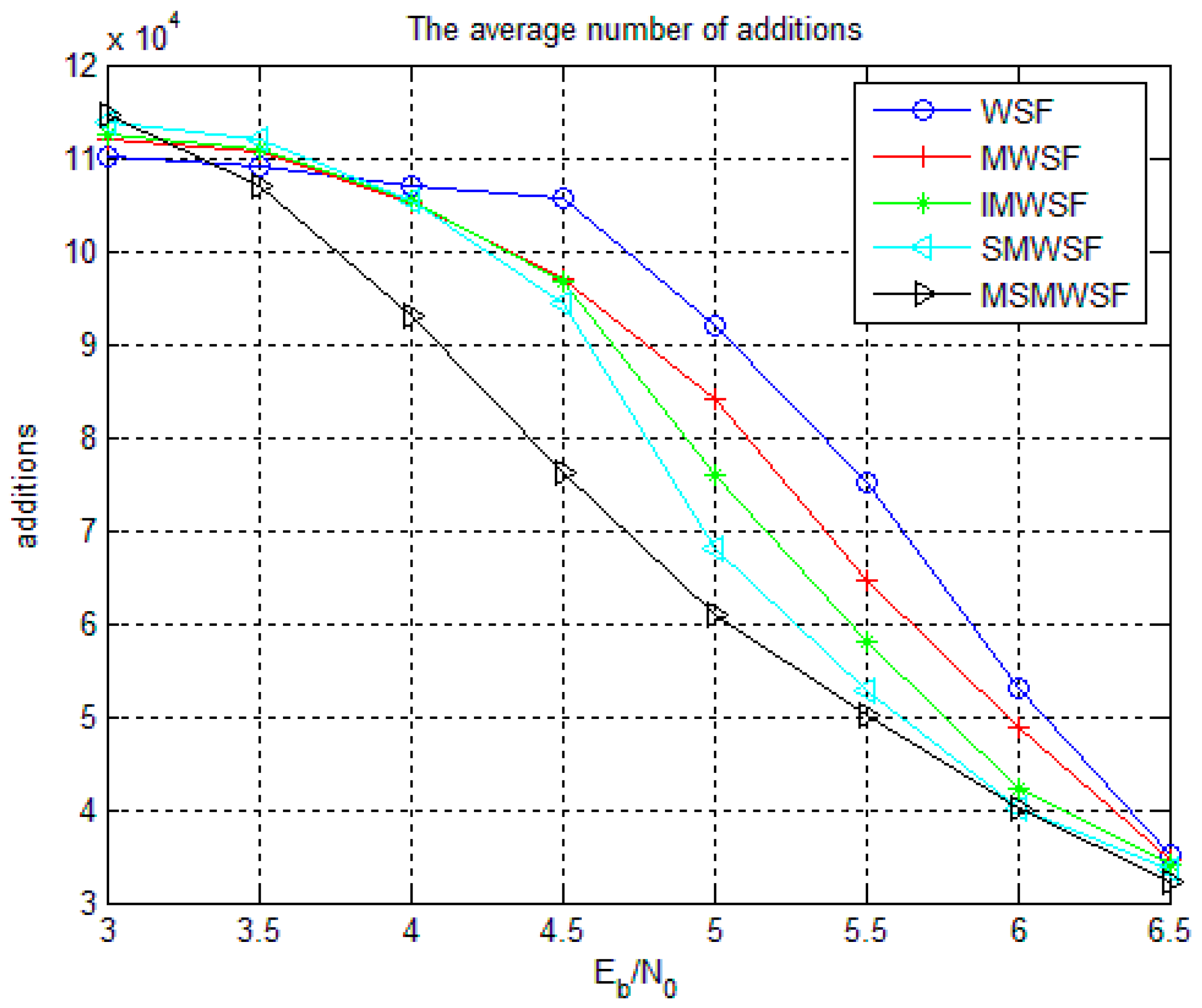
| SF Algorithm | Addition Operations | Multiplication Operations | Division Operations |
|---|---|---|---|
| WSF | 0 | 0 | |
| SMWSF | 0 | 0 | |
| MSMWSF | 0 | 0 | |
| LUDSMWSF | 0 | 0 | |
| LUDMSMWSF | 0 | 0 | |
| FFT-BP |
| SF Algorithm | Decoding Failure Frames |
|---|---|
| WSF algorithm | 9915 |
| MWSF algorithm | 9840 |
| IMWSF algorithm | 6544 |
| SMWSF algorithm | 6200 |
| MSMWSF algorithm | 4184 |
| SF Algorithm | Addition Operations | Multiplication Operations | Division Operations |
|---|---|---|---|
| WSF algorithm | 205644 | 0 | 0 |
| MSMWSF algorithm | 92710 | 0 | 0 |
| FFT-BP algorihtm | 567723 | 744870 | 66267 |
© 2018 by the authors. Licensee MDPI, Basel, Switzerland. This article is an open access article distributed under the terms and conditions of the Creative Commons Attribution (CC BY) license (http://creativecommons.org/licenses/by/4.0/).
Share and Cite
Meng, J.; Zhao, D.; Tian, H.; Zhang, L. Sum of the Magnitude for Hard Decision Decoding Algorithm Based on Loop Update Detection. Sensors 2018, 18, 236. https://doi.org/10.3390/s18010236
Meng J, Zhao D, Tian H, Zhang L. Sum of the Magnitude for Hard Decision Decoding Algorithm Based on Loop Update Detection. Sensors. 2018; 18(1):236. https://doi.org/10.3390/s18010236
Chicago/Turabian StyleMeng, Jiahui, Danfeng Zhao, Hai Tian, and Liang Zhang. 2018. "Sum of the Magnitude for Hard Decision Decoding Algorithm Based on Loop Update Detection" Sensors 18, no. 1: 236. https://doi.org/10.3390/s18010236
APA StyleMeng, J., Zhao, D., Tian, H., & Zhang, L. (2018). Sum of the Magnitude for Hard Decision Decoding Algorithm Based on Loop Update Detection. Sensors, 18(1), 236. https://doi.org/10.3390/s18010236




